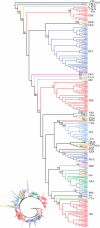Tangled in a sparse spider web: single origin of orb weavers and their spinning work unravelled by denser taxonomic sampling
- PMID: 22048955
- PMCID: PMC3282380
- DOI: 10.1098/rspb.2011.2011
Tangled in a sparse spider web: single origin of orb weavers and their spinning work unravelled by denser taxonomic sampling
Abstract
In order to study the tempo and the mode of spider orb web evolution and diversification, we conducted a phylogenetic analysis using six genetic markers along with a comprehensive taxon sample. The present analyses are the first to recover the monophyly of orb-weaving spiders based solely on DNA sequence data and an extensive taxon sample. We present the first dated orb weaver phylogeny. Our results suggest that orb weavers appeared by the Middle Triassic and underwent a rapid diversification during the end of the Triassic and Early Jurassic. By the second half of the Jurassic, most of the extant orb-weaving families and web designs were already present. The processes that may have given origin to this diversification of lineages and web architectures are discussed. A combination of biotic factors, such as key innovations in web design and silk composition, as well as abiotic environmental changes, may have played important roles in the diversification of orb weavers. Our analyses also show that increased taxon sampling density in both ingroups and outgroups greatly improves phylogenetic accuracy even when extensive data are missing. This effect is particularly important when addition of character data improves gene overlap.
Figures


References
-
- Selden P. A., Shear W. A., Sutton M. D. 2008. Fossil evidence for the origin of spider spinnerets, and a proposed arachnid order. Proc. Natl Acad. Sci. USA 105, 20 781–20 78510.1073/pnas.0809174106 (doi:10.1073/pnas.0809174106) - DOI - DOI - PMC - PubMed
-
- Brunetta L., Craig C. L. 2010. Spider silk: evolution and 400 million years of spinning, waiting, snagging, and mating. New Haven, CT: Yale University Press
-
- Vollrath F., Selden P. 2007. The role of behavior in the evolution of spiders, silks, and webs. Annu. Rev. Ecol. Evol. Syst. 38, 819–84610.1146/annurev.ecolsys.37.091305.110221 (doi:10.1146/annurev.ecolsys.37.091305.110221) - DOI - DOI
-
- Chacon P., Eberhard W. G. 1980. Factors affecting numbers and kinds of prey caught in artificial spider webs, with considerations of how orb webs trap prey. Bull. Br. Arachnol. Soc. 5, 29–38
-
- Peñalver E., Grimaldi D. A., Delclòs X. 2006. Early Cretaceous spider web with its prey. Science 312, 1761–176110.1126/science.1126628 (doi:10.1126/science.1126628) - DOI - DOI - PubMed
Publication types
MeSH terms
Substances
LinkOut - more resources
Full Text Sources
Molecular Biology Databases

